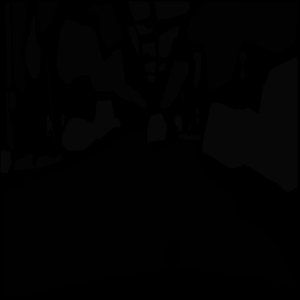Training for image segmentation
Image segmentation is the task of predicting a class for every pixel in an image. This allows to very finely delimitates objects and shapes of many classes from within images, at once.
Data format
- Image segmentation image & mask example


Image segmentation main image list format from
/opt/platform/examples/cityscapes/train.txt:/opt/platform/examples/cityscapes/train/imgs//konstanz_000000_001391_leftImg8bit.png /opt/platform/examples/cityscapes/train/annot/konstanz_000000_001391_gtCoarse_labelTrainIds.png /opt/platform/examples/cityscapes/train/imgs//dortmund_000000_000053_leftImg8bit.png /opt/platform/examples/cityscapes/train/annot/dortmund_000000_000053_gtCoarse_labelTrainIds.png /opt/platform/examples/cityscapes/train/imgs//heidelberg_000000_001065_leftImg8bit.png /opt/platform/examples/cityscapes/train/annot/heidelberg_000000_001065_gtCoarse_labelTrainIds.png /opt/platform/examples/cityscapes/train/imgs//berlin_000170_000019_leftImg8bit.png /opt/platform/examples/cityscapes/train/annot/berlin_000170_000019_gtFine_labelTrainIds.png
We suggest to organize the files as follows:
your_data/train
your_data/train/train.txt
your_data/train/annot
your_data/train/annot/annot_img1.png
your_data/train/annot/annot_img2.png
...
your_data/train/imgs
your_data/train/imgs/img1.jpg
your_data/train/imgs/img2.jpg
...
your_data/test
your_data/test/test.txt
your_data/test/annot
your_data/test/annot/annot_img100.png
your_data/test/annot/annot_img200.png
...
your_data/test/imgs
your_data/test/imgs/img100.jpg
your_data/test/imgs/img200.jpg
...
The DD platform has the following requirements for training from images for segmentation:
- All data must be in image format, most encoding supported (e.g. png, jpg, …)
- For every image, there’s a mask describing the class of every pixel of the image, itself in the form of an 8-bit 1-channel image. In other words, the mask must be a black and white image (single channel) with values from 0 to 255 maximum. Each value represents a class, so for a two classes model (background and an object type), pixels can only be 0 or 1. For a two classes segmentation problem, pixels can only be 0, 1 or 2, etc… See examples on the right
A main text file lists all image paths and their image mask counterpart, using space as a separator. See on the right for data format and example.
You need to prepare both a
train.txtandtest.txtfile for training and testing purposes.
DD platform comes with a custom Jupyter UI that allows testing your image segmentation dataset prior to training:

Training an image segmenter
Using the DD platform, from a JupyterLab notebook, start from the code on the right.
Image segmentation notebook snippet:
city_seg = Segmentation(
'city_psp',
training_repo='/opt/platform/examples/cityscapes/train.txt',
testing_repo='/opt/platform/examples/cityscapes/test_shuf50.txt',
host='deepdetect_training',
port=8080,
img_height=480,
img_width=480,
model_repo='/opt/platform/models/training/examples/cityscapes/',
nclasses=8,
template='pspnet_vgg16',
iterations=75000,
test_interval=1000,
snapshot_interval=1000,
batch_size=6,
test_batch_size=1,
noise_prob=0.001,
distort_prob=0.001,
gpuid=0,
base_lr=0.001,
weights='/opt/platform/models/pretrained/pspnet_vgg16/vgg16_init_deeplab.caffemodel',
solver_type="AMSGRAD",
finetune=True,
rotate=False,
mirror=True,
resume=False,
loss='dice_weighted'
)#.run()
city_seg
This prepares for training an image segmentere with the following parameters:
city_pspis the example job name
training_repospecifies the location of the data
templatespecifies a PSPNet with VGG-16 basis that has state of the art performances.lossspecifies the loss to be used to train the model. For two-classes problems,diceworks best. For multi-class problems, weighersoftmaxordice_weightedare recommended. When usingsoftmaxloss, see how to useclass_weightsfrom the main API documentation at https://deepdetect.com/api/#launch-a-training-job at it improves training of segmentation tasks that in general have very unbalanced classes.img_widthandimg_heightspecify the input size of the image, see the recommended models section to adapt to other architectures available.noise_probanddistort_probcontrol the random occurence of tens of data augmentation schemes.0.001is usually a good value for both when data is scarce.mirroractivates mirroring of inputs as data augmentation for both the input image and the maskrotateactivates rotation of inputs as data augmentation for both the input image and the mask (e.g. useful for satellite images, …)finetuneautomatically prepares the network architecture for finetuningweightsspecifies the pre-trained model weights to start training fromsolver_typespecifies the optimizer, see https://deepdetect.com/api/#launch-a-training-job andsolver_typefor the many optionsbase_lrspecifies the learning rate. For finetuning mask detection models, 1e-3 works well.gpuidspecifies which GPU to use, starting with number 0
Recommended models for image segmentation
The platform has many neural network architectures and pre-trained models built-in for image segmentation. These range from state of the art architectures like PSPNet and Deeplab for state of the art, U-Net for flexibility and SE-Net for low-memory and embedded tasks.
Below is a list of recommended models for image classification from which to best choose for your task.
| Model | Template | Image size | Pre-Trained (/opt/platform/models/pretrained) | Recommendation |
|---|---|---|---|---|
| PSPNet | 480x480 | pspnet_vgg16 |
pspnet_vgg16/vgg16_init_deeplab.caffemodel | Fast / Excellent accuracy /desktops |
| Deeplab | 480x480 | deeplab_vgg16 |
deeplab_vgg16/vgg16_init_deeplab.caffemodel | Fast / Excellent accuracy / desktops |
| U-Net | 480x480 | unet |
none, from scratch | Flexible / Very good accuracy / embedded & desktops |
| E-Net | 480x480 | enet |
none, from scratch | Fast / Average accuracy / embedded |
| SE-Net | 224x224 | se_net |
none, from scratch | Extremely fast / Average accuracy / embedded |